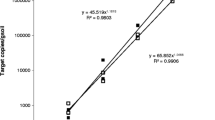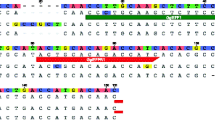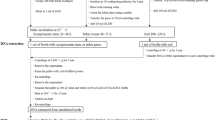Abstract
The disease syndrome ‘Basses richesses’ (SBR) affects sugar beet (Beta vulgaris) crops and causes important economic damage in eastern France. Up to now two phloem-restricted prokaryotes which cannot be cultivated, a stolbur phytoplasma and a γ-3 proteobacterium (called SBR proteobacterium), have been associated with the disease. The SBR proteobacterium is closely related to endosymbionts of Hemiptera in the genus Arsenophonus. Both the phytoplasma and the proteobacterium are transmitted by the insect vector Pentastiridius sp. (Hemiptera: Cixiidae). In the present work, we developed sensitive PCR tools for routine detection of SBR proteobacteria in sugar beets. The monitoring with PCR since 1997, of both SBR pathogen agents, showed the predominant aetiological role of SBR proteobacteria in SBR disease. Detection of SBR proteobacteria in sugar beet was correlated with development of SBR symptoms and reduction of sugar content in the taproot. Severity of symptoms and sugar content in experimentally inoculated sugar beet plants were a function of the number of Pentastiridius sp. used for transmission or the length of inoculation access period (IAP), suggesting a direct relationship between importance or precocity of populations of inoculative insects in fields and low sugar yield of crops.



Similar content being viewed by others
References
Altschul, S. F., Madden, T. L., Schaeffer, A. A., Zhang, J., Zhang, Z., Miller, W., & Lipman, D. J. (1997). Gapped BLAST and PSI-BLAST: A new generation of protein database search programs. Nucleic Acids Research, 25, 3389–3402.
Deng, G., & Hiruki, C. (1991). Amplification of 16S rRNA genes from culturable and non culturable Mollicutes. Journal of Microbiological Methods, 14, 53–61.
Fos, A., Danet, J. L., Zreik, L., Garnier, M., & Bové, M. (1992). Use of monoclonal antibody to detect the stolbur mycoplasmalike organism in plants and insects and to identify a vector in France. Plant Disease, 76, 1092–1096.
Gatineau, F. (2002). Rôle étiologique du phytoplasme du stolbur et d’un bacterium-like organism (BLO) dans le syndrome des basses richesses (SBR) de la betterave sucrière (Beta vulgaris L.). Epidémiologie de la maladie et biologie du vecteur identifié, le cixiide Pentastiridius beieri, Wagner. Dijon (France). PhD Thesis. Université de Bourgogne, Sciences de la Vie et de la Santé.
Gatineau, F., Jacob, N., Vautrin, S., Larrue, J., Lherminier, J., Richard-Molard, M., & Boudon-Padieu, E. (2002). Association with the syndrome “basses richesses” of sugar beet of a phytoplasma and a bacterium-like organism transmitted by a Pentastiridius sp. Phytopathology, 92, 384–392.
Gatineau, F., Larrue, J., Clair, D., Lorton, F., Richard-Molard, M., & Boudon-Padieu, E. (2001). A new natural planthopper vector of stolbur phytoplasma in the genus Pentastiridius (Hemiptera: Cixiidae). European Journal of Plant Pathology, 107, 263–271.
Higgins, D. G., & Sharp, P. M. (1988). CLUSTAL: A package for performing multiple sequence alignment on a microcomputer. Gene, 73, 237–244.
ICUMSA: International commission for uniform methods of sugar analysis. Réfractométrie et tables officielles SPS-3, 2000.
Lorenz, K. H., Schneider, B., Ahrens, U., & Seemüller, E. (1995). Detection of the apple proliferation and pear decline phytoplasmas by PCR amplification of ribosomal and non ribosomal DNA. Phytopathology, 85, 771–776.
Maixner, M. (1994). Research note: Transmission of German grapevine yellows (Vergilbungskrankheit) by the planthopper Hyalesthes obsoletus (Auchenorrhyncha: Cixiidae). Vitis, 33, 103–104.
Montllor, C. B., Maxmen, A., & Purcell A.H. (2002). Facultative bacterial endosymbionts benefit pea aphids Acyrthosiphon pisum under heat stress. Ecological Entomology, 27, 189–195.
Muchembled, C., Garressus, S., Ecalle, F., Boudon-Padieu, E., & Gatineau, F. (1999). Low sugar content syndrome. In: Proceedings of the fifth international conference on pests in agriculture (pp. 529–536). Montpellier (France): Association Nationale pour la Protection des Plantes (ANPP).
Oliver, K. M., Russell, J. A., Moran, N. A., & Hunter, M. S. (2003). Facultative bacterial symbionts in aphids confer resistance to parasitic wasps. Proceedings of the National Academy of Sciences of the United States of America, 100 (4), 1803–1807.
Richard-Molard, M., Garressus, S., Malatesta, G., Orny, G., Valentin, P., Reinbold, C., Gerst, M., Blech, F., Fonne, G., Putz, C., Grousson, C., & Boudon-Padieu, E. (1995). Le syndrome des basses richesses—Investigations au champ et tentatives d’identification de l’agent pathogène et du vecteur. In: Proceedings of 58th international institute for beet research congress (pp. 299–309). Dijon-Beaune (France).
Sémétey, O., Gatineau, F., Bressan, A., & Boudon-Padieu, E. (2007) Characterization of a γ-3 proteobacteria responsible for the syndrome “basses richesses” of sugar beet transmitted by Pentastiridius sp. (Hemiptera, Cixiidae). Phytopathology, 97, 72–78.
Sforza, R., Daire, X., Clair, D., Larrue, J., & Boudon-Padieu, E. (1998). The role of Hyalesthes obsoletus (Hemiptera: Cixiidae) in the occurrence of Bois noir of grapevine in France. Journal of Phytopathology, 146, 549–556.
Smart, C. D., Schneider, B., Blomquist, C. L., Gerra, L. J., Harrison, N. A., Ahrens, U., Lorenz, K. H., Seemüller, E., & Kirkpatrick, B. C. (1996). Phytoplasma-specific PCR primers based on sequences of the 16S rRNA spacer region. Applied and Environmental Microbiology, 62, 2988–2993.
Tedeschi, R., Ferrato, V., Rossi, J., & Alma, A. (2006). Possible phytoplasma transovarial transmission in the psyllids Cacopsylla melanoneura and Cacopsylla pruni. Plant Pathology, 55, 18–24.
Weisburg, W. G., Barns, S. M., Pelletier, D. A., & Lane, D. J. (1991). 16S ribosomal DNA amplification for phylogenetic study. Journal of Bacteriology, 173, 697–703.
Zreik, L., Bové, J. M., & Garnier, M. (1998). Phylogenetic characterization of the bacterium-like organism associated with marginal chlorosis of strawberry and proposition of a Candidatus taxon for the organism, ‘Candidatus Phlomobacter fragariae’. International Journal of Systematic Bacteriology, 48, 257–261.
Acknowledgments
This work was funded by the Institut technique français de la betterave industrielle and the Conseil Régional de Bourgogne.
Author information
Authors and Affiliations
Corresponding author
Rights and permissions
About this article
Cite this article
Sémétey, O., Bressan, A., Richard-Molard, M. et al. Monitoring of proteobacteria and phytoplasma in sugar beets naturally or experimentally affected by the disease syndrome ‘Basses richesses’. Eur J Plant Pathol 117, 187–196 (2007). https://doi.org/10.1007/s10658-006-9087-3
Received:
Accepted:
Published:
Issue Date:
DOI: https://doi.org/10.1007/s10658-006-9087-3




